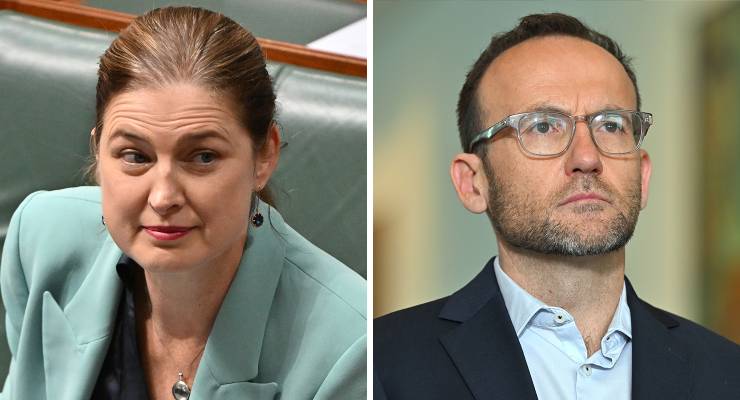
As rents skyrocket and housing vacancies plummet, the Greens are blocking Labor’s legislation to build 30,000 social and affordable homes.
Housing Minister Julie Collins says it’s time to “stop the delays and pass the bill”. In return for their votes, the Greens are demanding Labor invest more in housing and impose a rent freeze. At stake is Labor’s $10 billion housing Australia future fund, a key election pledge.
The fund won’t directly finance new dwellings; it will be invested. Annual returns will then provide an ongoing subsidy, bridging the gap between the cost of building and operating homes and the low rents paid by tenants. This secure revenue stream will flow to housing providers, enabling them to construct dwellings by raising finance from other sources, such as superannuation funds.
Seen in a positive light, the housing fund leverages a modest amount of public money to access large sums of private capital for social good. Seen critically, it is a complex workaround to save the government from the hard political work of raising revenue for housing by reforming investor concessions such as negative gearing and the capital gains tax discount.
Labor says the fund could generate up to $500 million a year, although it has failed to specify an annual minimum spend. Since its inception, the Future Fund has generated an average annual return of 7.8%, but last year it lost 1.2%. Given the potential for volatility, the Greens say it’s possible there’ll be no money for new homes until after the next election.
Home truths
This is the basis of the Greens’ assertion that we wouldn’t fund education or health by “gambling on the stock market”. The refrain is becoming tiresome, but they have a point.
A report for the Australian Housing and Urban Research Institute concluded that direct public investment is the cheapest and most efficient way to fund social housing — and this is what the Greens want. They are pushing the government to commit $2.5 billion annually, halving their earlier demand of $5 billion.
This would come closer than the housing fund to matching the magnitude of Australia’s housing crisis.
Depending on which source you consult, between 331,000 and 640,000 Australian households spend more than they can afford on housing, and there are 163,500 households on public housing waiting lists. Four in 10 of those are classified as “greatest need”, meaning they are homeless or their accommodation imperils their life, safety or health.
As it stands, the housing fund won’t make an appreciable dent on this yawning need.
If it lives up to its promise (which the Greens doubt), it will finance 20,000 new units of “social” housing — homes reserved for people on very low incomes (often government payments), where rents are capped at 30% of income so there’s enough money left for other essentials such as heating and food. Priority is given to those at risk of homelessness, such as women and children fleeing family violence.
In addition, there will be 10,000 “affordable” homes aimed at “key” workers in low-wage sectors such as aged care and childcare. These homes are let at a discount to prevailing market rates.
Like the Rudd government’s social housing initiative in response to the global financial crisis of 2007-08, the housing fund is a one-off. Once the promised 30,000 homes over five years are subsidised, annual returns will be fully committed for decades and there’ll be no money left to finance more housing. Unless it’s redesigned, it will be but another blip in the decades-long decline in building homes for struggling Australians.

Gloves are on
Yet isn’t something better than nothing? Even a blip would put some roofs over some heads.
However, this may be the Greens’ only opportunity to muscle Labor on housing during the life of this Parliament. The housing Australia future fund will also set a second-rate precedent for how social housing is financed in future. If the Greens can get Labor to commit to a modest annual spend on social housing as well, they keep the door open to the superior approach of direct public investment.
On the other hand, Labor can defend its fund on the basis it wouldl be hard to scrap if the Coalition returned to government. Budget spending is easily reversed, but having institutional investors tied up in a scheme makes it harder to undo.
If it was a straight-up fight between these two positions — Labor’s one-off fund with the vague promise of up to $500 million a year for housing, versus the Greens’ push for an annual spend of $2.5 billion — the Greens would have a good chance of winning the public argument.
Their other demand for a two-year rent freeze complicates matters. It will appeal to renters, including in inner-city Labor electorates, but it is a blunt instrument. The government argues it would have unintended consequences, like deterring new housing investment, and also that tenancy laws are a state matter.
Meeting halfway?
What are the options for compromise? First, Labor could offer to top up the fund with additional capital annually, so that it generates a steadily rising, guaranteed minimum sum to be invested in social and affordable housing year after year. Only sustained funding long into the future can address the scale of Australia’s housing need.
Second, Labor needs to do more than ask state and territory housing ministers to “develop a proposal” to strengthen renters’ rights. It could use its political and financial clout to lead a substantial charge on tenancy reform, including at least investigating sophisticated mechanisms for regulating private rents like those used in Germany or the Netherlands.
The stakes are high. Labor risks losing renting voters in heartland seats and failing to respond adequately to the housing challenge; the Greens risk being tarnished as the party that stopped 30,000 urgently needed homes from being built.
Let’s hope that behind the scenes they are hammering out a workable compromise.
Should Labor back down? Let us know by writing to letters@crikey.com.au. Please include your full name to be considered for publication. We reserve the right to edit for length and clarity.








The fact that Labor takes an all or nothing approach to this (take my crappy policy or we will do nothing at all, average australian be damned) just says more about Labor then the Greens. They don’t care.
No, the Greens shouldn’t back down. They’re the only ones who seem to give a damn about our many and mounting existential crises.
Next vote Greens and independent
Rundle has already pointed out the uselessness of Labor’s Future Fund, both in terms of its efficiency, and its inability to deal with the problem of homelessness for many years. Houses – or apartments – are needed now. Right now. How this is achieved in the complexities of an ailing building industry, a ruthless and shadowy property lobby, a ‘me-first’ attitude of homeowners, and the spectre of wedge politics is what needs to be put into action. Someone has to stand up and cut through the bulls***. Hundreds of billions spent on submarines almost on a whim, but we can’t cure the accommodation crisis?
just cause ya worked and got one home does not make a greedy homeowner – nany never took one holiday and bought when the country was not over run by corporate pirates abs sell off of our riads, health and pathology and business and cheap gas off shore and on shore with lobby mates of neo lib govt – 20 bill to Qantas despite the ruin of an unblemished recordthe CEO AND directors got million dollar bonus to downsize local crews / sack loyal staff get contracted offshore staff – hows that for younger and older Australians and our ability to buy our first flat and over years upsize to get some green space – why assumed its just about people on the ground – wake up its multi property buying consortiums and investment groups
The fund won’t directly finance new dwellings; it will be invested. – sounds about as dumb as the LNP giving money to businesses during the covid crisis, instead of giving it to the workers
It is one point on what should be a policy – its a ted herring cynically paraded and could go North or South – they should keep private developer funding out of the sca/: scheme more importantly why should private company investor dollars be making dividended profits on our lands and infrastructure it will never end the g
ministers in this country have lost the plot
something isn’t better than nothing, if the something is a) derisory, and b) has as its sole purpose to give Labor a way to spin its inaction on housing. If the latter is clearly the overwhelming purpose of the fund – which might, only might, build 2-3,000 houses a year, for 5 years, beginning in a few years – then to not challenge it is to reward cynicism, and to reward a strategy that prevents clear-eyed debate on the challenge.
The problem is Labor’s complete capture by “small government” neoliberalism. Even Menzies funded public housing with deficit spending.
A better scheme would be for the government to lay prior claim on say, half the nation’s building resources (inc.labour) to avoid inflation, until the public housing stock is restored, and fund it housing via ‘debt free’ money issuance in the Treasury. See Prof. Steve Keen:
(8) How to Make Money – by Steve Keen (substack.com)
“Fiat creates money for the non-bank private sector; interest on bonds creates money for the banking sector; and the turnover of money creates GDP. Far from the servicing of government debt being a burden on future generations, as Neoclassical economists claim, the payment of interest on government bonds finances the banking sector while the excess of government spending over taxation creates money and positive equity for the non-bank private sector.”
And fiat of course is created ex nihilo by the nation’s Treasury, so any quantum of government debt is moot, provided resources are mobilized sustainably.